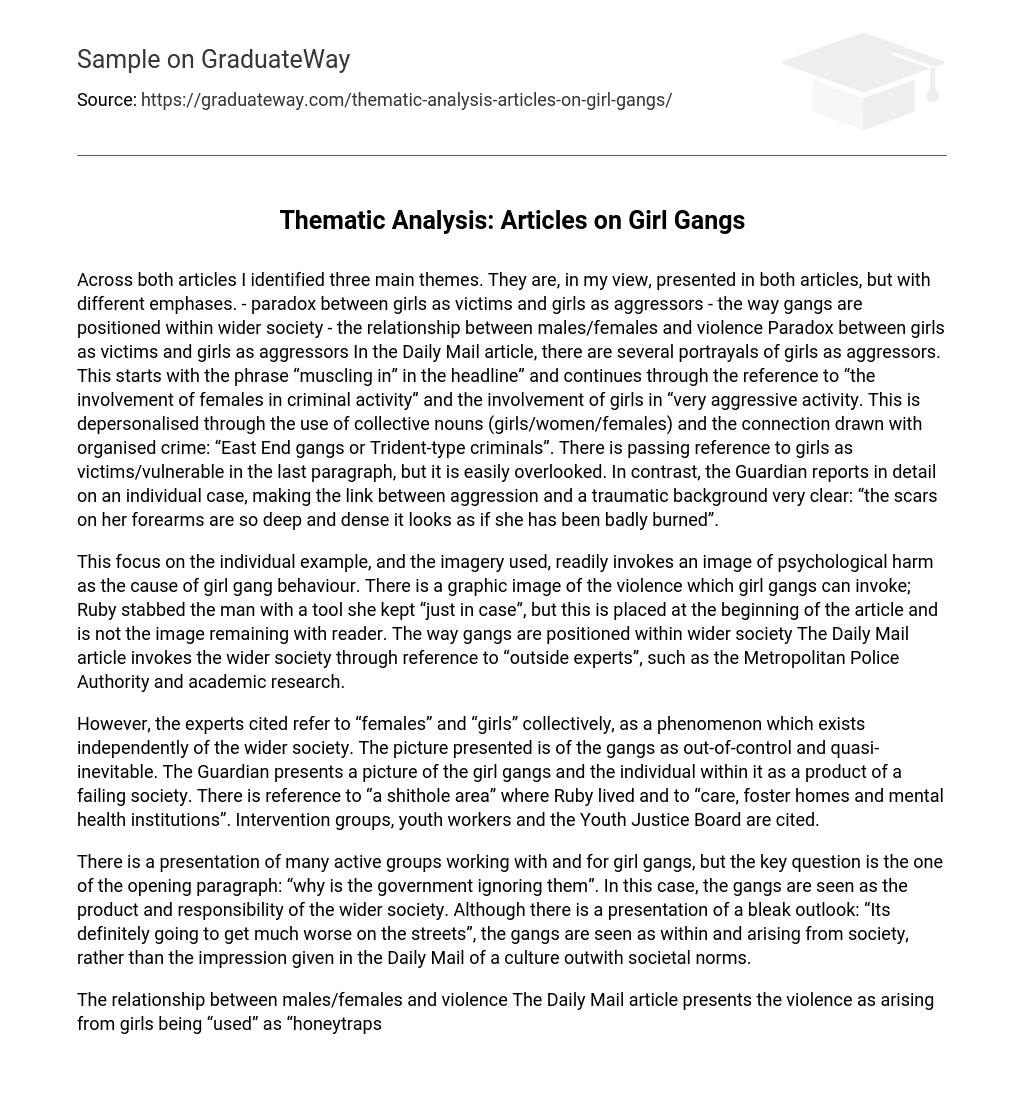Across both articles I identified three main themes. They are, in my view, presented in both articles, but with different emphases. – paradox between girls as victims and girls as aggressors – the way gangs are positioned within wider society – the relationship between males/females and violence Paradox between girls as victims and girls as aggressors In the Daily Mail article, there are several portrayals of girls as aggressors. This starts with the phrase “muscling in” in the headline” and continues through the reference to “the involvement of females in criminal activity” and the involvement of girls in “very aggressive activity. This is depersonalised through the use of collective nouns (girls/women/females) and the connection drawn with organised crime: “East End gangs or Trident-type criminals”. There is passing reference to girls as victims/vulnerable in the last paragraph, but it is easily overlooked. In contrast, the Guardian reports in detail on an individual case, making the link between aggression and a traumatic background very clear: “the scars on her forearms are so deep and dense it looks as if she has been badly burned”.
This focus on the individual example, and the imagery used, readily invokes an image of psychological harm as the cause of girl gang behaviour. There is a graphic image of the violence which girl gangs can invoke; Ruby stabbed the man with a tool she kept “just in case”, but this is placed at the beginning of the article and is not the image remaining with reader. The way gangs are positioned within wider society The Daily Mail article invokes the wider society through reference to “outside experts”, such as the Metropolitan Police Authority and academic research.
However, the experts cited refer to “females” and “girls” collectively, as a phenomenon which exists independently of the wider society. The picture presented is of the gangs as out-of-control and quasi-inevitable. The Guardian presents a picture of the girl gangs and the individual within it as a product of a failing society. There is reference to “a shithole area” where Ruby lived and to “care, foster homes and mental health institutions”. Intervention groups, youth workers and the Youth Justice Board are cited.
There is a presentation of many active groups working with and for girl gangs, but the key question is the one of the opening paragraph: “why is the government ignoring them”. In this case, the gangs are seen as the product and responsibility of the wider society. Although there is a presentation of a bleak outlook: “Its definitely going to get much worse on the streets”, the gangs are seen as within and arising from society, rather than the impression given in the Daily Mail of a culture outwith societal norms.
The relationship between males/females and violence The Daily Mail article presents the violence as arising from girls being “used” as “honeytraps”. The psychologists’ comment that girls are “meant to be nurturing, caring and supportive” seems to imply that aggression is a male prerogative. Throughout the article the implict and explicit script suggests that male aggression is a given, but the female role “should” be different. Girls in gangs are seen as stepping outside the norm, in part as the victims who are “taken advantage of”.
The Guardian presents a more independent view of females, with the aggression seen to arise from an abusive/traumatic background, which would impact on males and females alike. The Guardian does point out the relative invisibility of girls involved in gangs, compared to the male youth: “Girls, however, have mostly remained in the shadows, unless they are portrayed as spectators goading the boys on . . . girls are much more hidden in the harm they do”. This is a reflection on the different roles of males and females in society and a general unwillingness to recognise the involvement of emales in violence. Having obtained the above themes I would be inclined to analyse the articles in terms of sociocultural theory, looking at how the gangs are seen as part of society or otherwise and the extent to which government and the welfare state takes responsibility for such social phenomena. There is also potential for exploring the perception of males/females in society and the associated perception of normative/deviant atttitudes to violence and how the different newspapers present these to their different target audiences.





